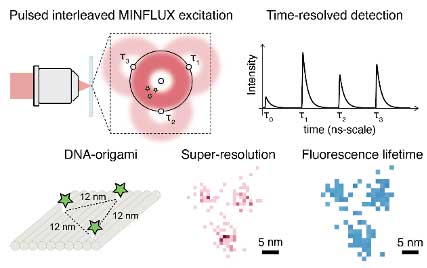| Jan 05, 2021 |
Fluorescence microscopy at highest spatial and temporal resolution
(Nanowerk News) Only a few years ago, it was shown that the spatial resolution of fluorescence microscopy has no fundamental limit. The discovery of super-resolution microscopy led to the 2014 Nobel Prize in Chemistry.
|
|
Since then, the achievable resolution was only limited by fluorophore stability and brightness until 2017, when another quantum leap in this area was made possible by a technique called MINFLUX. MINFLUX is the most photon-efficient method to locate single fluorescent molecules, and thereby enables nanoscopy down to the molecular dimension (1 nm).
|
|
MINFLUX estimates the position of a fluorescent molecule from four subsequent measurements of its emission intensity using doughnut-shaped foci displaced in space (Figure 1).
|
|
Scientists at the LMU Munich and the University of Buenos Aires have now succeeded in implementing a new version of MINFLUX, the second worldwide. The new method, called Pulsed Interleaved MINFLUX,p-MINFLUX, delivers the same nanometric resolution with a simplified setup. In addition, it has the unique advantage of giving access to fluorescence lifetime measurements.
|
 |
| Figure 1: Principle of p-MINFLUX including the excitation scheme (top) and the super-resolved fluorescence lifetime image (bottom). (Image courtesy of the researchers)
|
|
In the approach developed by the groups led by Professor Philip Tinnefeld (LMU) and Professor Fernando Stefani (Buenos Aires), the four doughnut-shaped foci are made from four time-interleaved laser pulses. In this way, the position estimation of MINFLUX can be performed at maximum speed (the repetition rate of the laser used). Using fast (picosecond) electronics, each detected photon is assigned to the corresponding excitation doughnut.
|
|
In the present publication (Nano Letters, "Pulsed Interleaved MINFLUX"), the scientists succeeded in showing that the new p-MINFLUX method enables the visualization of local distribution of the fluorescence lifetime, the most important measured variable to characterize the environment of dyes, with a resolution of 1 nm.
|
|
Philip Tinnefeld explains: "With p-MINFLUX it will be possible to uncover structures and dynamics at the molecular level that are fundamental for our understanding of energy transfer processes up to biomolecular reactions."
|
|
This project was funded by the German Research Foundation (Cluster of Excellence e-conversion, SFB1032), the Council for Scientific and Technological Research (CONICET) and the National Agency for the Promotion of Research, Technological Development and Innovation (ANPCYT) in Argentina. Prof. Stefani is the Georg Forster Prize winner of the Alexander von Humboldt Foundation and, in this role, a regular guest scientist in physical chemistry at LMU Munich.
|

